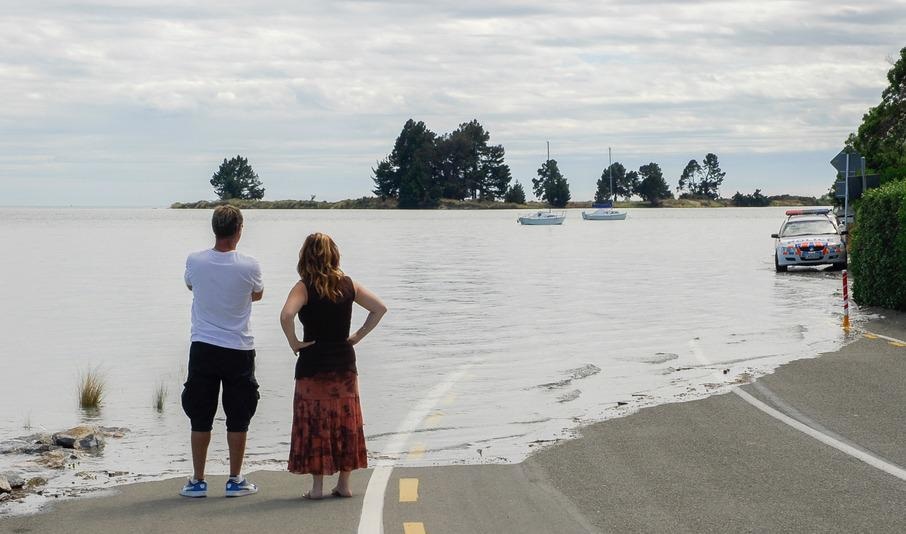Global sea levels have risen 16 cm since 1902 – an estimated 3.6 mm per year, driven by warming oceans, melting mountain glaciers, and mass losses from the Greenland and Antarctic ice sheets. It is less than half a centimeter per year, but even small rises can have a devastating effect on coastal habitats and threaten human life and infrastructure.

Image Credit: MainlanderNZ/Shutterstock.com
Human-driven warming is to blame, and if carbon dioxide and greenhouse gases continue to increase at their current rates, the Intergovernmental Panel on Climate Change (IPCC) predicts sea levels will rise between 26 cm and 77 cm by 2100.
This encroachment of seawater onto the land contaminates freshwater, aquifers, and agricultural soils with salt, erodes the land, causes wetland flooding and loss of habitat, animals, and plants. Researchers from the University of Adelaide have developed a method to analyze sulfur isotopes in water samples to see exactly what effect this seawater infringement is having on the environment.
The research became available online in the journal Talanta on 15 July 2021 and is due to be published on 1 December 2021.
Sulfur in Seawater
Sulfur isotopes are powerful indicators of environmental change, used to investigate chemical adjustments in aquatic environments such as oceans, freshwater rivers, and lakes. This new method can be employed to trace the effect of sea level rises on such by detecting seawater intrusion.
Sulfur isotopes can tell us a great deal about Earth cycles both now and in the past. Different water sources have different levels of sulfur isotopes within them. The processes that occur within an environment such as the intrusion of seawater into freshwater systems can change these ratios.
Emily Leyden, PhD student, School of Biological Sciences, University of Adelaide
By analyzing sulfur isotope ratios, researchers can gain vital insights into how environments are changing, adds Leyden.
Old Versus New Analysis of Sulfur Isotopes
Sulfur isotopes are traditionally analyzed using mass spectrometry (MS); the samples are split into their ions with those of interest measured depending on their mass to charge ratio, which differs among isotopes of the same chemical element.
But it can be difficult to differentiate results; the mass to charge ratio among ions can disperse and overlap, known as spectral interference. Furthermore, sulfur must undergo a complex chemical purification before being analyzed to ensure reliable measurements – this is expensive, difficult, and time-consuming.
Leyden and her team, which included experts in metal isotopes and microscopy from the University of Adelaide and Flinders University, developed a simple, inexpensive and fast method to measure sulfur isotopes without complex sample purification.
The technique also uses inductively coupled plasma (ICP) MS to solve the spectral interference problem. Sulfur is combined with another element – oxygen in this instance – to increase the mass to charge ratio and lower the risk of interference, allowing the sulfur isotopes to be accurately measured.
Real-World Simulations of Seawater Flooding
The scientists simulated how the method could work in real-world applications. Here, response to seawater inundation was observed by tracing seawater flooding into various coastal environments in Southern Australia, including freshwater streams and lakes, hypersaline salt marsh sites, and sites known to have acid sulfate materials.
It is particularly timely and important given there is rapid global environmental change, and the method enables easier detection of seawater intrusion into freshwater systems due to sea-level rise.
Luke Mosely, Prinicple PhD Supervisor and Associate Professor, School of Biological Sciences, University of Adelaide
Following flooding, the original sulfur isotope of the soil water changed to that of the seawater isotope. According to the researchers, the isotope ratios could also provide clues to the sample’s individual and unique composition before flooding.
This new technique opens up the sulfur measurement to several new environmental applications across many disciplines.
“Using this new method, scientists can measure sulfur isotopes in environmental samples easily following only simple dilution of the sample of interest,” continues Mosely.
The Future of Sulfur in Monitoring Climate Change
There is growing interest in using sulfur isotopes as a sensitive tool to trace the influence of seawater inundation on coastal ecosystems impacted by climate change-induced sea-level rise. This technique has the potential to trace sulfur isotope composition in a range of natural waters – particularly coastal systems with a wide range in sulfur isotope variability due to water source mixing.
Given the global concerns around sea-level rise and its effects on our climate, the technique could be used in routine monitoring to detect seawater intrusion. Before this can happen, further studies are required to improve how intrusion and inundation effects are monitored and quantified in different locations.
References and Further Reading
Leyden, E et al. (2021) A simple and rapid ICP-MS/MS determination of sulfur isotope ratios (34S/32S) in complex natural waters: A new tool for tracing seawater intrusion in coastal systems, Talanta. Available at: https://doi.org/10.1016/j.talanta.2021.122708. Accessed 16 August 2021.
University of Adelaide. (2021) New method to detect impact of sea level rise. EurekAlert. [Online] Available at: https://www.eurekalert.org/news-releases/924242. Accessed 16 August 2021.
Royalsociety.org. (2020) 14. How fast is sea level rising?. [Online] Available at: https://royalsociety.org/topics-policy/projects/climate-change-evidence-causes/question-14/. Accessed 16 August 2021.
Nunez, C. (2019) Sea level rise, explained. [Online] National Geographic. [Online] Available at: https://www.nationalgeographic.com/environment/article/sea-level-rise-1. Accessed 16 August 2021.
Disclaimer: The views expressed here are those of the author expressed in their private capacity and do not necessarily represent the views of AZoM.com Limited T/A AZoNetwork the owner and operator of this website. This disclaimer forms part of the Terms and conditions of use of this website.